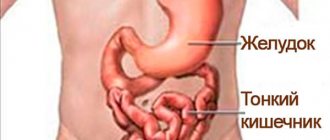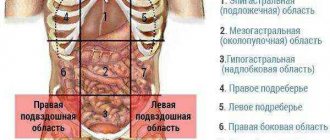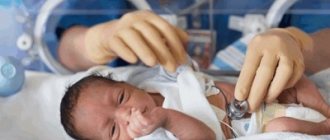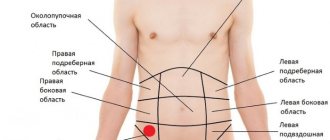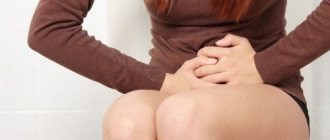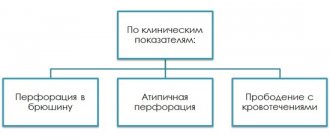Total information
This disease occurs quite often - it occurs in various forms at least once in a lifetime in, according to various sources, 70-95% of the population. Ileitis happens:
- isolated, when only the ileum is affected;
- combined – if observed together with inflammatory lesions of other parts of the digestive tract.
Most often, ileitis is combined with:
- duodenitis (inflammation of the duodenum);
- jeunitis (inflammation of the jejunum, which is located between the duodenum and ileum).
Please note:
Most people get sick at a young age - from 20 to 40 years. The male gender suffers somewhat more often.
In general, the chronic form of the disease accounts for, according to various sources, from 5 to 7% of all inflammatory pathology of the small and large intestines - this is considered a high degree of damage. This fact is explained by the fact that ileitis is often not detected, and therefore is not treated in time: the location of the ileum prevents a full diagnosis of inflammatory processes in it, since the diagnosis is made mainly on the basis of symptoms, excluding damage to other parts of the intestine - instrumental diagnosis is difficult, since the ileum is inaccessible for immersing a probe into it during fibrogastroduodenoscopy. Due to insufficient diagnosis of ileitis, doctors often follow erroneous treatment tactics.
Crohn's disease - treatment
Due to the lack of precisely known causes of the described chronic pathology, special therapy to eliminate it has not yet been developed. All options for treating Crohn's disease come down to stopping the inflammatory process, preventing complications and relapses. The main methods of therapy are medication and diet. In the presence of severe consequences of terminal ileitis, surgical intervention is performed.
Crohn's disease: treatment - drugs
The main direction in the treatment of the disease is to relieve inflammation and restore the normal digestive process. Terminal ileitis - treatment involves taking the following pharmacological agents:
- glucocorticoids – Prednisolone, Methylprednisolone;
- salicylates – Mesazaline, Sulfasazalin;
- immunosuppressants – Methotrexate, Azathioprine;
- topical hormones – Budesonide, Beclazone;
- antibiotics – Rifaximin, Ciprofloxacin;
- genetically engineered biological drugs – Etanercept, Infliximab and others.
Crohn's disease continues to be researched, so scientists are constantly looking for new ways to combat terminal ileitis. The following are considered promising options:
- integrin receptor blockers – Vedolizumab;
- live donor or genetically modified bacteria;
- sorbents;
- conjugated linoleic acid;
- DNA sequencing;
- nanotechnological drugs;
- enzymes;
- plasmapheresis;
- stem cells – Polychrome;
- placement in a hyperbaric chamber;
- marijuana products - Naltrexone;
- plasma absorption;
- vaccines against inflammatory bowel pathologies;
- preparations based on pig worm eggs (TSO) and others.
Diet for Crohn's disease
All gastroenterologist patients with this diagnosis are required to be prescribed a special diet. The diet for terminal ileitis is selected taking into account the nature of the disease and the presence of complications. The milder the degree of pathology, the more products are allowed for consumption. Diet for Crohn's disease requires exclusion:
- fresh flour and bakery products;
- snacks;
- rich broths;
- vegetable and cereal soups;
- smoked meats;
- milk and dairy products;
- fatty meat, fish;
- canned food;
- barley, millet, pearl barley porridge;
- legumes;
- any sweets;
- vegetables;
- cold and carbonated drinks;
- cocoa or coffee with milk.
- dishes made from lean fish or minced meat, steamed or boiled (soufflé, cutlets, etc.);
- crackers made from premium flour;
- calcined or pureed unleavened cottage cheese;
- weak or low-fat broths with the addition of egg flakes, meatballs, slimy cereal broths (from semolina, rice);
- eggs (soft-boiled, steam omelet);
- butter as a seasoning for dishes;
- grated raw apples;
- pureed oatmeal, rice, semolina porridge with water;
- green tea;
- coffee or cocoa with water;
- berry fruit drinks;
- diluted fruit juices;
- jelly;
- rosehip decoction.
Causes
Ileitis happens:
- acute – more often observed in children;
- chronic – it most often affects adults. The chronic form is often characterized by a relapsing course - alternating periods of calm and exacerbations.
The contents of the human intestine are not sterile, and ileitis is often caused by an infection of the ileum - bacterial or viral.
The causative agents of chronic ileitis are:
Yersinia - more often than any other infectious agent. Yersinia is a representative of enterobacteria, which, unlike many other infectious pathogens, is able to survive and reproduce at low temperatures (1-4 degrees Celsius, which corresponds to the temperature of the internal environment of a refrigerator), and also withstand significant heating;- salmonella;
- staphylococci;
- coli;
- worms;
- Giardia is one of the most common protozoan parasites in the human body.
The acute form of ileitis, in addition to the indicated pathogens, can also be caused by viruses, such as pathogens:
- rotaviruses;
- enteroviruses.
A number of factors have also been identified that can equally contribute to the occurrence of both acute and chronic forms of ileitis. This:
- increased sensitization of the body (allergization);
- smoking;
- alcohol abuse;
- violation of the principles of proper nutrition - abuse of fatty, fried, seasoned, extractive (causing increased secretion of secretions and gastrointestinal enzymes) foods;
- intoxication. Household and industrial poisons, fungal toxins, heavy metals and substances used as chemical reagents are important;
- taking certain groups of medications;
- enzymopathies - a violation of the secretion of enzymes, which, in turn, disrupts normal digestion. Often, enzymopathies are characterized by a hereditary predisposition;
- surgical intervention for diseases of the gastrointestinal tract.
In general, acute ileitis develops due to damage to the ileum against the background of an aggravating factor (most often, a nutritional disorder). The chronic form of the disease in the vast majority of cases develops in those people who:
ignore an active lifestyle;- lean on fatty, fried, spicy foods and alcohol;
- have concomitant diseases of the gastrointestinal tract. Most often, inflammatory lesions of the ileum develop in diseases of the gastrointestinal tract such as chronic pancreatitis, cholelithiasis, chronic cholangitis (inflammation of the biliary tract);
- underwent surgery on the abdominal organs with the subsequent development of adhesions.
Acute and chronic ileitis can occur both as a primary form of the disease and as a secondary manifestation of certain diseases - in particular, these are:
- tuberculosis;
- yersiniosis – generalized (general) damage to the body by yersinia;
- typhoid fever;
- Crohn's disease - the formation of granulomas - small tubercles - in the gastrointestinal tract;
- ulcerative colitis.
Depending on the cause of occurrence, all ileitis is divided into:
- parasitic;
- infectious;
- medicinal;
- nutritional (food);
- toxic;
- enzymatic;
- postoperative;
- mixed - with a combination of several reasons (for example, infection and eating disorders).
Classification
By level of damage
- Localized (only the ileum, most often the terminal area, is affected).
- Widespread (with the transition of the inflammatory reaction to other parts of the small or large intestine).
- Ileitis, combined with gastritis, pancreatitis and other pathologies of the gastrointestinal tract.
Due to the occurrence
- Infectious ileitis (viral, bacterial, fungal, parasitic).
- Medicinal (inflammation caused by prolonged exposure to the mucous membrane of certain medications).
- Toxic (biological or chemical toxins).
- Autoimmune (Crohn's disease).
- Enzymatic (aggressive action of its own enzymes: atrophic and non-atrophic ileitis).
- Nutritional factors (poor nutrition, junk food, lack of a meal plan).
- Postoperative ileitis.
With the flow
- Easy degree.
- Average.
- Heavy current.
Also, ileitis can be acute and chronic (the process lasts more than 6 months), which depends on the cause, age, characteristics of the immune system’s response, and therapeutic measures.
According to the nature of intestinal tissue damage
- Catarrhal inflammation (affects only the mucous membrane).
- Erosive (formation of deep erosions up to the muscular or serous layer, sometimes with perforation of the intestinal wall). The most unfavorable variant of the course of terminal ileitis.
Course of the disease
Ileitis happens:
- primary – occurs in a person with a healthy gastrointestinal tract;
- secondary - appears against the background of another pathology of the digestive tract.
Based on enzymatic activity, there are two forms of this disease:
- atrophic;
- non-atrophic.
Downstream, the following forms of ileitis are distinguished:
- light;
- medium-heavy;
- severe without complications;
- severe with complications.
If we are talking about chronic, long-lasting ileitis, then its stages are distinguished as:
- exacerbations;
- incomplete remission - the process of restoration of the mucous membrane of the ileum and its return to normal is underway, clinically a partial subsidence of symptoms is observed;
- complete remission - the mucous membrane is almost restored, clinically there is a complete subsidence of symptoms.
Important
From the point of view of tissue changes in the mucous membrane of ileitis, classic signs of inflammation are observed - redness, swelling of tissues, increased local temperature, soreness, which is manifested by abdominal pain, deterioration in the absorption capacity of the ileum.
Crohn's disease - symptoms
The clinical manifestations of the presented pathology correspond to its degree, localization and duration of the inflammatory process, the frequency of relapses and other factors. There are some nonspecific signs that accompany terminal ileitis - general symptoms:
- fever or wave-like increase in temperature;
- weakness;
- constant fatigue;
- weight loss;
- stomach ache;
- lack of appetite;
- diarrhea lasting more than 6 weeks.
Terminal catarrhal ileitis
This type of disease is characterized by inflammation only of the mucous membranes of the gastrointestinal tract. Catarrhal Crohn's disease may be accompanied by intestinal and extraintestinal symptoms. The first group of clinical manifestations includes:
- pain simulating acute appendicitis;
- nausea;
- anorexia;
- vomiting;
- bloating;
- chronic diarrhea.
Extraintestinal signs of Crohn's disease:
- conjunctivitis, uveitis or keratitis;
- aphthous stomatitis;
- sclerosing cholangitis;
- cirrhosis;
- pyelonephritis;
- fatty liver;
- cholelithiasis;
- cystitis;
- hydronephrosis;
- cholangiocarcinoma;
- kidney amyloidosis;
- nephrolithiasis.
Terminal follicular ileitis
A large number of Peyer's patches are located in the submucosal layer of the small intestine and ileum. These are special lymphoid follicles designed to produce immunoglobulins. Terminal ileitis often affects such structures, resulting in the already listed symptoms and additional clinical manifestations:
- exposure to frequent infections, especially viral ones;
- ankylosing spondylitis;
- erythema nodosum;
- pyoderma gangrenosum;
- angiitis;
- adhesions;
- monoarthritis;
- peritonitis;
- fistula tracts;
- intra-abdominal abscesses;
- narrowing of the lumen and intestinal obstruction;
- sustained increase in body temperature.
Erosive terminal ileitis
The Crohn's disease in question is characterized by the formation of deep ulcerations on the mucous membranes of the gastrointestinal tract. Inflammation in combination with erosive processes is considered one of the most dangerous forms of terminal ileitis, leading to dangerous and life-threatening consequences. Peptic ulcer Crohn's disease - manifestations:
- perforation of the intestinal walls;
- internal bleeding;
- toxic megacolon;
- abscesses as a result of secondary infection.
Symptoms of ileitis
Classic symptoms of inflammatory lesions of the ileum are:
- stomach ache;
- dyspeptic disorders;
- hyperthermia (increased body temperature);
- signs of deterioration in the general condition of the body.
Characteristics of pain:
- by location - in the right iliac region (lower right abdomen);
- by irradiation - can radiate to nearby areas of the abdomen and to the navel;
- by nature - they can be either aching, “protracted”, or in the form of attacks, cramping;
- in intensity – from moderately intense to very strong.
note
Dyspeptic disorders - nausea, vomiting, diarrhea, rumbling in the abdomen, bloating, loose stools - occur in the acute form of ileitis or in exacerbation of the chronic form.
Acute ileitis is characterized by:
- acute onset;
- violent symptoms;
- fairly short duration and quick recovery. There are cases when acute ileitis goes away on its own, without treatment.
Clinical symptoms characteristic of acute ileitis are as follows:
pain in the right iliac region is acute, short-term, and can be relieved after the patient visits the toilet;- frequent loose stools. Diarrhea is observed up to 20 times a day - the patient can leave the toilet and immediately, literally a minute later, return back when needed (a symptom of “toilet duty”);
- Abdominal pain is usually accompanied by nausea and vomiting. After vomiting, short-term relief occurs;
- body temperature rises to 39 degrees Celsius;
- The signs of general malaise are quite pronounced - headaches, weakness, the patient characterizes his condition as if he is staggering.
The chronic form of ileitis manifests itself with a more gradual onset. In 85-90% of all clinical cases, symptoms are moderately expressed - these are:
- low or moderate intensity, tolerable pain in the right iliac region, in some cases pain around the navel develops in parallel;
- bloating, but gas passes away;
- rumbling in the stomach, which at its peak is resolved by bowel movement;
- watery stools - the stools have a yellowish tint. If you have a bowel movement immediately after eating, you may find remains of undigested food (especially plant fibers) in your stool. Often the act of defecation does not bring a feeling of relief - on the contrary, abdominal pain may intensify after it;
- gradual moderate deterioration in the general condition of the body (may only appear several months after the onset of the disease, but its symptoms are steadily increasing).
According to some data, pain in the right iliac region is a sign of a chronic form of ileitis in 70% of all clinical cases (of which, most often with yersinia lesions).
Changes in the general condition appear due to constantly impaired absorption of nutrients (proteins, fats, carbohydrates), vitamins and mineral compounds. The most telling signs are:
- uncritical, gradual but progressive weight loss;
progressive deterioration in performance – both intellectual and physical;- sleep disturbances – insomnia at night or sensitive, restless sleep;
- deterioration of psychological mood - apathy and loss of interest in things that previously attracted attention;
- signs of hypovitaminosis - blurred vision, dry and brittle hair and nails, dry skin, formation of hematomas (bruises) with minor bruises, and so on;
- in later stages, osteoporosis gradually begins to develop - fragility of bone tissue. In patients with frequent fractures caused by not particularly pronounced efforts, the cause of such critical fragility should be sought in intestinal pathology - in particular, with prolonged inflammatory damage to the ileum.
What is intestinal ileitis and why is it dangerous? What treatment is prescribed for adults?
Intestinal ileitis is an inflammation of the ileum that has different origins. The small intestine itself has 3 sections (duodenum, ileum, jejunum). The state of the entire organism depends entirely on the harmonious functioning of these parts, because the absorption of the main share of nutritional components (microelements, vitamins) is carried out precisely in the small intestine.
General information
Ileitis is an inflammation located in the final part of the small intestine and spreading to nearby tissues. Causes the formation of ulcerative-scarring, polypoid bases. The lesion occurs both in the thermal region of the small intestine and in the duodenum, colon, and jejunum.
The pathology is observed very often - it appears in various forms, exactly once in a lifetime, in 75-95% of the planet's inhabitants.
Ileitis has 2 types:
- isolated - only the ileum is affected;
- combined – inflammation is also observed in other parts of the gastrointestinal tract.
The disease is mainly combined with duodenitis and jeunitis. Often people aged 20-40 years old get sick. Moreover, men are more susceptible to the disease than women. In rural residents, pathology occurs less frequently, approximately 2 times, than in people living in cities.
Statistical data have established that in 70% of situations, pain from the right iliac zone becomes a sign of the chronic development of ileitis. This pathology accounts for 6% of all inflammatory bowel processes.
Symptoms and complications of the disease
An acute inflammatory manifestation is characterized by an unexpected acute onset with an immediate increase in symptoms. The illness lasts for several days and often even goes away on its own without treatment.
Symptoms in adults in the acute form are as follows:
- pain in the iliac region;
- malaise, weakness;
- diarrhea up to 10 times per day;
- headache;
- rumbling, bloating;
- vomiting, increased body temperature;
- feeling of nausea.
Due to disruption of the digestive system, dehydration, convulsions, and blood clotting disorders can occur.
Symptoms of chronic ileitis are:
- aching pain in the navel area, the right side of the iliac region;
- hypovitaminosis;
- loose stools with undigested pieces of food;
- osteoporosis;
- loss of body weight (occurs due to impaired absorption of minerals and vitamins);
- rumbling, bloating.
If such signs appear, you should visit a specialist for timely therapeutic measures. If you do not act, complications may arise:
- malabsorption;
- the appearance of infiltrates of the abdominal cavity;
- the occurrence of fistulas;
- peritonitis;
- intestinal obstruction;
- sepsis;
- intestinal bleeding.
To prevent this, you need to start treatment for ileitis on time.
Drug treatment
Drug therapy and duration depend on the underlying cause of ileitis.
The following treatment is performed for ileitis:
- Glucocorticosteroids (Dexamethasone, Diprospan, Prednisolone) – in case of a complex illness with complications, the doctor prescribes these drugs.
- Antibiotics, antifungal, antiparasitic (Mycozoral, Metronidazole, Cefotaxime) - immunomodulatory antiviral drugs are used for young children with pathologies of viral origin.
- NSAIDs (Nimesulide, Ibuprofen, Meloxicam, Diclofenac) are anti-inflammatory painkillers.
- Cytostatics (Cytarabine, Azathioprine, Cyclophosphamide), immunosuppressants (Cyclosporine, Tacrolimus).
- Enzyme agents (Mezim, Creon) - taking enzyme agents helps improve digestion with reflux ileitis.
- Probiotics (Bifidumbacterin, Acipol, Linex) - replenish the body with all the necessary beneficial bacteria.
- Sorbents (Activated carbon, Polysorb, Polyphepan) - help remove harmful substances from the body during ileitis.
- To correct dehydration, infusion therapy is prescribed - protein, glucose, and electrolytes are injected into the blood intravenously.
Periodically, the doctor prescribes a course of astringent herbal medicines and vitamin complexes. When there is no exacerbation of the disease, patients with the chronic form are prescribed sanatorium-resort therapy.
Prevention, prognosis
In the acute form of ileitis, the prognosis will be positive. In the case of a chronic disease, the result depends on the stage of the inflammatory process of the intestines, symptoms, and laboratory data. The more complex the course of the disease, when there is a worsening of the pathology, the less favorable the prognosis of ileitis will be.
In order to prevent relapse of the disease, you need to adhere to a strict diet with plenty of vitamins and minerals.
It is important to visit a specialist in a timely manner, eliminate bad habits (smoking, alcohol), and sanitize places of chronic infection.
Prognosis and prevention will depend on how the patient feels about his health and whether he adheres to the specialist’s recommendations. And most importantly, intestinal ileitis should be treated at the first manifestations of the disease, only then will it be possible to avoid complications.
Source: https://gastrot.ru/kishechnik/ileit
Complications
If acute ileitis is accompanied by frequent severe diarrhea and vomiting, this can lead to its most important complication - dehydration. In most cases, it stops without problems, but if help is not provided or provided incorrectly, complications such as:
- hypovolemic shock (impaired microcirculation of blood in tissues due to reduced volume of circulating blood);
- convulsions;
- a disorder of the blood coagulation system.
Important
Also, chronic ileitis is often complicated by chronic mild but persistent intestinal bleeding.
In an extremely advanced state, if dehydration (dehydration) increases, death can occur.
Treatment of dehydration is considered illiterate if replenishment of fluid losses is carried out not by intravenous infusion of solutions, but by administering fluid through the mouth , and it is immediately removed from the body with liquid feces or vomit. This is one of the main reasons for the increasing dehydration of the body in this disease. Dehydration in acute ileitis (and damage to other parts of the gastrointestinal tract) is also called exicosis.
Prognosis and prevention
The prognosis is favorable for acute ileitis. With chronic inflammation, the prognosis will depend on the degree of intestinal damage, the clinical picture and laboratory parameters. The more severe the disease, the more complications, the less favorable the prognosis is considered.
To prevent relapses, it is necessary to follow a strict diet rich in minerals and vitamins, give up bad habits, sanitize foci of chronic infection, visit your doctor and undergo appropriate preventive examinations. The quality of life of patients with chronic ileitis is improved by taking enzyme preparations and anti-relapse treatment with hormones and cytostatics.
When a patient develops such a dangerous and difficult-to-treat disease as Crohn's disease, very often the pathological inflammation spreads to the ileum, thereby provoking the occurrence of terminal, or otherwise called reflux ileitis. It is always chronic and localized in the distal small intestine. Sometimes it can be combined with a pathological lesion that affects the duodenum, small intestine and cecum.
The morphological picture of ileitis usually reveals catarrhal-hemorrhagic inflammation, which is accompanied by a narrowing of the lumen in the digestive organ due to sclerosis of the walls with the formation of numerous erosions on them, developing into severe ulcerations. All this causes obstruction in the affected organ, which requires only surgical treatment.
In terminal ileitis, as in Crohn's disease, the etiology is not clear enough. Among the factors that provoke the occurrence of the disease, experts mostly identify the following:
- Genetic predisposition (heredity). The greatest tendency to develop the disease is in those people whose close relatives were susceptible to nonspecific pathologies of the digestive organs;
- An autoimmune reaction that occurs in the body;
- Imbalanced diet, exposure to bad habits and frequent stressful situations;
- Secondary viral or bacterial infections that occur in the body against a background of weakened immunity.
In addition, some experts believe that the cause of terminal ileitis, which is expressed by the development of inflammation in the ileum, is the failure of the valve located between the large and small intestines, called the bauhinian valve.
There are also opinions that this cause is a consequence of pathology. There is no clear opinion on this topic yet. All that can be said with certainty is that this valve is always involved in the process of development of ileitis.
Diagnostics
Diagnosing inflammatory lesions of the ileum only on the basis of complaints and medical history is problematic. Therefore, it is necessary to involve additional diagnostic methods.
Physical examination data in themselves are not highly informative, but are necessary in a comprehensive diagnosis of this disease:
upon examination it will be revealed that the tongue is dry, with a white coating - but this is a non-specific sign;- On palpation, the patient complains of moderate pain in the right iliac region. At the peak of dyspeptic symptoms (in particular, frequent diarrhea), rumbling is detected when the abdomen is palpated in the same area;
- during percussion, if the abdomen is swollen, a ringing sound is detected, as if beating on a drum;
- upon auscultation at the peak of diarrhea, an increase in peristaltic noise is heard, especially in the right iliac region.
When examining the stool, a characteristic light yellow tint of feces and the remains of undigested food will be revealed.
The data for acute and chronic forms of ileitis are almost similar - in acute forms, pain in the abdomen during palpation will be more pronounced.
Rectal examination of the rectum (with a gloved finger) at the peak of frequent bowel movements can reveal a gap in the rectum.
Data from instrumental diagnostic methods are not particularly informative, but they are used for a complex diagnostic process - more for differential diagnosis. The following methods are used:
radiography of the passage of barium through the small intestine - the patient is asked to drink a portion of barium sulfate and after half an hour a fluoroscopy and intestinal graph are performed. During the study, it is possible to identify areas of spasm of the ileum and a violation of the passage (movement) of barium sulfate - delayed emptying of the ileum from the contrast agent. In severe cases, there may be signs of dynamic (due to impaired intestinal motility) intestinal obstruction - in particular, the absence of barium passage;- fibrogastrododenoscopy (FGDS) - during it the probe does not reach the ileum, but this study will help to identify combined changes in the small intestine;
- Ultrasound examination of the abdominal organs (ultrasound) - will help to differentiate ileitis from diseases of the parenchymal organs of the abdominal cavity, the pathology of which may lead to similar clinical symptoms (abdominal pain, vomiting, and so on);
- multislice computed tomography (MSCT) – it can also be used to assess the condition of internal organs and verify the diagnosis.
Laboratory research is more informative in diagnosing ileitis. Methods such as:
- general blood test - it reveals an increased number of leukocytes and an increased ESR, which is indicative of the inflammatory process;
- biochemical blood test - a decrease in the amount of total protein and a violation of the ratio of protein fractions will be recorded. A decrease in the amount of microelements is also detected;
- virological and bacteriological examination of feces - pathogens of ileitis are identified under a microscope;
- coprogram - a large number of undigested food fragments, carbohydrates, as well as a reduced amount of enzymes are found in the stool;
- analysis of stool for occult blood - ileitis is often complicated by chronic bleeding, but blood in the stool is not visually detected, but only thanks to such an analysis.
Diet for terminal ileitis
A gastrointestinal disease such as terminal ileitis occurs spontaneously, and it is quite difficult to cure.
The consequences of ignoring the problem can take horrifying forms. What is the essence of this disease and how to cope with it? This kind of disease refers to intestinal problems. At its core, ileitis is an inflammatory process in the ileum of the small intestine, which is accompanied by the formation of ulcers and polyps, destruction of the mucous membrane up to the appearance of purulent fistulas. Most often, the disease develops in a young body between the ages of 15 and 20 years.
This disease is also known as reflux ileitis or Crohn's disease. The forms of manifestation may take the form of a sudden attack of colic, an acute recurrent nature, or a moderate one with permanent digestive upset. The chronic form does not allow you to eat normally and causes constant discomfort, which can lead to complete refusal to eat.
Symptoms
How to recognize ileitis? Symptoms of the disease are often similar to other diseases, so without accurate research it is almost impossible to make a diagnosis. It may be accompanied by completely foreign phenomena at first glance: skin rashes, inflammation of the mucous membranes of the mouth, eyes and nose, pain in the joints and kidneys.
But if some obvious signs appear, you need to be wary and get examined by a doctor. Their intensity will approximately indicate the stage of the disease. The main symptoms of terminal ileitis:
- increased body temperature for no apparent reason;
- abdominal pain similar to an attack of appendicitis;
- fever;
- pain in the ileum;
- colic;
- nausea and vomiting;
- bloating;
- anemia;
- diarrhea mixed with blood, mucus and pus;
- loss of appetite, refusal to eat;
- weight loss.
The more pronounced these manifestations of the disease are, the more severe the disease.
Causes
Intestinal ileitis can occur for a number of reasons, one of them is an infection that provokes the development of an inflammatory process.
It can enter the body with food or penetrate from other organs along with mucus and blood. This often occurs due to disturbances in the functioning of the bauhinium valve, which separates the small and large intestines.
This causes stagnation of intestinal contents, which leads to infection.
Another reason is poor nutrition and bad habits. Poor quality food, harmful products, and alcohol irritate the intestinal mucosa, which leads to its damage. A sedentary lifestyle further aggravates the situation. This factor generally causes about half of all existing diseases.
Ileitis can also be caused by:
- autoimmune reaction of the body;
- weakening of the immune system after illness, which leads to the development of secondary infection;
- genetic predisposition to gastrointestinal diseases.
The combination of several predisposing factors usually leads to more severe and rapidly progressive ileitis.
Consequences
Without treatment, the disease, which is already difficult to cure completely, tends to take a long time. Chronic ileitis will torment the patient throughout his life.
With progressive destruction of the intestinal mucosa, acute attacks of pain, bloody diarrhea become more frequent, and the temperature rises.
Inflammation spreads to other parts of the intestine, affecting not only the small intestine, but also other areas.
If no measures are taken, intestinal obstruction develops in the future. Its inner membrane becomes covered with scars and ulcerative lesions, pus accumulates, which leads to extensive peritonitis. Fistulas penetrate even into neighboring organs, metabolic processes are disrupted, and protein deposits accumulate in the organs. In this case, surgery cannot be avoided.
Diagnosis and treatment
If there is a suspicion of ileitis, treatment involves conducting preliminary studies to make an accurate diagnosis, identify foci of inflammation and determine the stage of the disease. Typically, several samples of blood, urine and stool are taken for testing. An ultrasound examination is performed, and in severe forms of the disease, a tissue sample is taken for biopsy.
Then anti-inflammatory and painkillers, antibacterial therapy, steroid hormones, and vitamins are prescribed. A prerequisite is adherence to a diet and abstinence from alcohol.
The emphasis is on foods rich in fiber. Animal proteins in the diet are reduced.
Gradually, you need to develop the habit of eating on a schedule, and introduce regular exercise to prevent relapses.
Plasma transfusions are also performed to cleanse the body.
For a comprehensive effect, additional symptomatic treatment is carried out, which is selected individually for each patient, depending on the characteristics of the manifestation of the disease. It can be directed both to other organs of the gastrointestinal tract, and to the excretory system or skin.
Source: https://limto.ru/dieta-pri-terminalnom-ileite/
Differential diagnosis
Differential (distinctive) diagnosis of inflammatory lesions of the ileum should first of all be carried out with those diseases that are characterized by diarrhea. These are pathologies such as:
- food poisoning;
- thyrotoxicosis – increased thyroid function;
- dysentery – infection of the gastrointestinal tract by Shigella;
- nonspecific ulcerative colitis;
- irritable bowel syndrome - with it there is an intestinal disorder without morphological changes in its wall;
- Addison's disease is a chronic insufficiency of the adrenal cortex, the clinical picture of which, among other symptoms, is characterized by abdominal pain and diarrhea.
Treatment of ileitis
A patient with acute ileitis must be hospitalized in a hospital - competent correction of dehydration will be necessary, which can only be carried out with the help of infusion therapy carried out under medical supervision. In addition to the gastroenterologist, an infectious disease specialist should also take part in the treatment of infectious ileitis.
Conservative therapy for acute ileitis is based on the following:
diet. It is based on fractional, frequent intake of mechanically, chemically and thermally gentle food - in other words, food should be crushed, not hot, with the exception of spicy, salty and extractive (that is, causing an increased secretion of enzymes, gastric and intestinal juices) products, easily digestible and enriched with vitamins. For vomiting and diarrhea, hunger is prescribed;- antibacterial therapy - taking into account the isolated pathogen and its sensitivity;
- infusion therapy - used to correct dehydration (for vomiting and diarrhea) and for detoxification of the body (for infectious nature of ileitis). In this case, glucose, protein solutions, and electrolytes are administered intravenously;
- enzyme preparations - they are prescribed to facilitate the processing and absorption of food;
- astringents and sorbents - prescribed for prolonged diarrhea;
- antispasmodics - they are administered according to indications for severe pain;
- probiotics – needed to normalize normal intestinal microflora;
- complex vitamins - are used even if food for ileitis is fortified.
Prescriptions for chronic ileitis will be as follows:
- diet;
- enzymes - to improve digestion;
- probiotics – to enrich the normal intestinal microflora;
- vitamin therapy. Vitamins are prescribed in the form of complexes that also contain minerals;
- in case of impaired bowel movements (loose stools), use astringents (can also be of plant origin).
Features of dietary nutrition are as follows:
- exclude rough, hot, spicy, fried, fatty foods;
- include lactic acid products;
- a sufficient amount of proteins, vitamins and microelements is necessary;
- limit carbohydrates (as they can provoke fermentation in the intestines) and fats;
- meals should be fractional – 4-5 times a day, in small portions.
If the cause of ileitis is hereditary fermentopathy, then such a diet should be followed throughout your life.
note
Treatment of chronic ileitis is long-term, sometimes up to several months. But even with successful treatment, relapses are not excluded.
Treatment
All cases of acute ileitis in children or acute complicated ileitis in adults are treated in a hospital setting.
For mild cases, outpatient therapy is possible with periodic monitoring by a gastroenterologist and infectious disease specialist, if required. Treatment of acute ileitis can last up to two weeks, chronic - up to 6 months. Be sure to read:
Jejunum: location, structure and functions
The key to a speedy recovery is medication, diet and lifestyle changes.
Diet
The principles of diet therapy are based on the exclusion of spicy, fatty, smoked and canned foods; too hot or cold foods are also not recommended. Meals are divided into fractions, up to 5-6 times a day.
| Recommended Products | Not Recommended Products |
|
|
Read on the topic: The use of herbs for inflammatory bowel pathologies
Drug therapy
The drug regimen and duration of treatment will depend on the suspected cause of ileitis:
- for infections, antibiotics (cephalosporins, fluoroquinolones, Biseptol, Metronidazole), antifungal and antiparasitic agents are prescribed. Antiviral immunomodulatory drugs are indicated for children with a viral nature of the disease.
- in severe cases of terminal ileitis with complications (erosion, ulceration of the mucous membrane), glucocorticosteroids (Prednisolone, Budesonide) are recommended.
- Cytostatics (Methotrexate), immunosuppressants (Infliximab).
- Antimicrobial agents (Sulfasalazine).
- Non-steroidal anti-inflammatory drugs (Diclofenac, Nimesulide).
- Sorbents (Smecta, Polysorb), probiotics (Hilak forte), multivitamins, mineral complexes.
- Enzymes (Creon, Mezim).
Surgical therapy
Surgical treatment is required if complications occur, such as:
- bleeding;
- perforation of the intestinal wall;
- adhesions with obstructed patency;
- fistulas;
- abdominal abscesses.
Prevention
Measures designed to prevent ileitis are standard, as for all diseases of the digestive tract - these are:
- rational nutrition with adherence to regular meals (breakfasts, lunches, dinners) and the inclusion of sufficient quantities of all nutrients;
refusal to drink alcohol and smoke. Alcohol damages the mucous membrane of the ileum, nicotine impairs the local blood supply to the intestine and contributes to a more pronounced manifestation of disorders on the part of its wall;- timely detection and elimination of an infectious agent in the intestine - before it has time to provoke pronounced changes in its mucous membrane;
- for hereditary enzymopathies - take enzyme preparations after consulting a doctor.
Forecast
The prognosis for acute ileitis is favorable. In the case of chronic inflammatory lesions of the ileum, the prognosis depends on how severe the damage to the mucous membrane of the intestinal wall is. The prognosis improves with strict adherence to the doctor’s recommendations (diet, and, if necessary, taking enzyme preparations).
Untreated or poorly treated chronic ileitis leads to gradual exhaustion of the patient and deterioration of the functioning of all organs and systems that do not receive enough nutrients. Critical dehydration is extremely rare, with completely advanced ileitis with vomiting and diarrhea - in this case, death is possible.
Kovtonyuk Oksana Vladimirovna, medical observer, surgeon, consultant doctor
20, total, today
( 49 votes, average: 4.30 out of 5)
Causes of constipation after introducing complementary foods, how to help your child
Esophageal burn: causes, symptoms, first aid and treatment
Related Posts
Ileitis (inflammation of the ileum): types, symptoms and treatment
Ileitis is inflammation of the ileum of various origins. The human small intestine consists of three sections: duodenum, jejunum and ileum. The health of the whole organism will depend on the coordinated work of all parts, since the absorption of the main share of nutrients (vitamins, microelements, amino acids, fatty acids) occurs in the small intestine.
